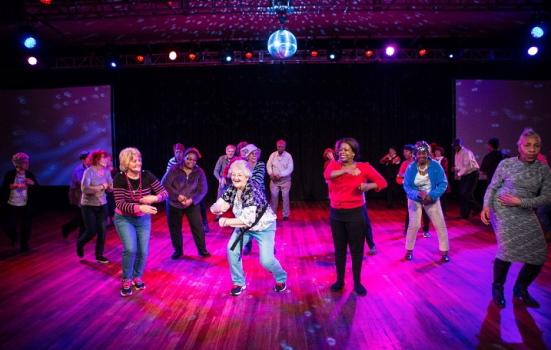Older people’s dance classes encourage long-term engagement, but artists face challenges developing relationships with doctors, a survey has found.

Helen Murray
Older people dancing can be an effective alternative to NHS programmes, but artists leading such activities need support to relay these benefits to non-dance sectors, according to a study by Aesop and People Dancing.
The two organisations conducted a survey of dance providers on their £350k ‘Dance to Health’ programme as a “snapshot of current practice” and to gather views about the conditions required for success.
The research found older people’s dance activities are most commonly described as ‘creative’ and have an emphasis on the social and community aspects of groups. The researchers added that these benefits can be used to encourage long-term participation in exercise.
More than just exercise
“It is useful to note that although dancing has physical benefits, it is also a social, cognitive and often emotionally positive activity,” said Sara Houston, Chair of People Dancing.
“The exciting aspect of dancing for older people is that the health benefits are broad and are channelled through artistic activity.”
Although the survey found that dance activities for older people are mainly delivered for health and wellbeing or artistic reasons, with ‘preventing illness’ a much less frequently cited objective, the potential for healthcare is evident.
“For patients, Dance to Health is more attractive,” said Tim Joss, Aesop’s Founder and Chief Executive. “The completion rate for [NHS] exercise courses is 40%. Dance to Health achieved 73%, plus a range of health, artistic and social benefits.”
Challenges
The artists leading dancing for older people were found to be professionally trained, but mostly operating outside of dance agency networks under a range of business and financial models.
The report identifies that the challenges facing artists operating as ‘micro-businesses’ are different depending on context, but include the recruitment and retention of new members, securing funding, space and volunteer support.
It also refers to the challenge of keeping artistic practice “fresh and engaging”, and having the “technical” knowledge to work safely with older peoples’ various health conditions.
Recommendations
The report recommends supporting people to articulate the worth of dance to non-dance specific partners. In particular, it suggests that building a relationship with people in health organisations – specifically GPs – currently relies on individual champions, and new support could “unlock” partnerships and supporters.
It suggests building stronger practice networks to bring the diverse body of dance together, and providing “regular, affordable and accessible training and development opportunities” to help improve art form skills and age-specific knowledge.
It also says there needs to be a consideration of how public funding is used to meet the needs of the aging population, given that by 2024, it is estimated that 25% of local authority areas will have a population in which one in four is aged 65 or over.
NHS alternative
‘Dance to Health’ was created in response to falls amongst older people, which cost the NHS £2.3bn per year, and a desire to prove that major national health problems can have artistic solutions that are “more effective and more cost-effective than current NHS services”.
Dance artists involved in the programme were trained in the use of two evidence-based falls prevention programmes, Otago and FaME, which were then delivered to groups of participants.
Sara Houston said: “These dance activities are able to reach and engage people in long term participation because they are artistic in nature and fun to do. Art is at the foundation of dance’s offer to older people.”




